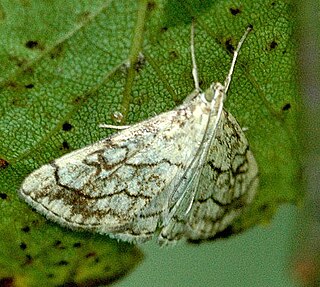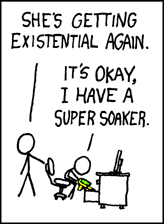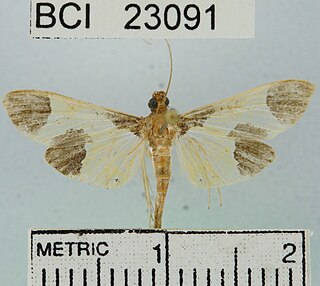Related Research Articles

Randall Patrick Munroe is an American cartoonist, author, and engineer best known as the creator of the award-winning webcomic xkcd. With a background in physics and robotics, Munroe has worked full- time on the comic since late 2006, publishing three times a week to a very large audience. Several of the strips, notably a visualisation of radioactivity levels, were also republished by other outlets. In addition to publishing a book of the webcomic's strips, he has written three books: What If?, Thing Explainer, and How To.

Evergestinae is a fairly small subfamily of the lepidopteran family Crambidae, the crambid snout moths. The subfamily was described by H. Marion in 1952. It contains roughly 140 species on all continents and continental islands. Evergestine moths resemble Pyraustinae; however, the male genitalia have a long uncus and long, slender gnathos. The larvae feed mostly on Brassicaceae.

xkcd, sometimes styled XKCD, is a webcomic created in 2005 by American author Randall Munroe. The comic's tagline describes it as "A webcomic of romance, sarcasm, math, and language". Munroe states on the comic's website that the name of the comic is not an initialism, but "just a word with no phonetic pronunciation".

Anageshna is a monotypic moth genus of the family Crambidae described by Eugene G. Munroe in 1956. Its only species, Anageshna primordialis, the yellow-spotted webworm, was described by Harrison Gray Dyar Jr. in 1907. It is found in the US states of Alabama, Arkansas, Arizona, Florida, Georgia, Iowa, Illinois, Kansas, Louisiana, Massachusetts, Maryland, Maine, Minnesota, Missouri, Mississippi, North Carolina, New Hampshire, New Jersey, New York, Ohio, Oklahoma, Pennsylvania, South Carolina, Texas, Virginia and West Virginia.
Argyrarcha is a monotypic moth genus of the family Crambidae described by Eugene G. Munroe in 1974. Its only species, Argyrarcha margarita, described by William Warren in 1892, is found on Madagascar.
Cuneifrons is a monotypic moth genus of the family Crambidae described by Eugene G. Munroe in 1961. Its only species, Cuneifrons coloradensis, described by the same author in the same year, is found in the US state of Colorado.

Evergestis is a genus of moths of the family Crambidae described by Jacob Hübner in 1825. A number of species are pests, including the cross-striped cabbageworm, a pest of cole crops such as cabbage.
Laniipriva is a monotypic moth genus of the family Crambidae described by Eugene G. Munroe in 1976. It contains only one species, Laniipriva antobliqua, described by the same author in the same year, which is found in Venezuela.
Mimophobetron is a monotypic moth genus of the family Crambidae described by Eugene G. Munroe in 1950. It contains only one species, Mimophobetron pyropsalis, described by George Hampson in 1904, which is found in Central America, the Bahamas and Florida.
Nehydriris is a monotypic moth genus of the family Crambidae described by Eugene G. Munroe in 1974. It contains only one species, Nehydriris excellens, described by the same author in the same year, which is found in Rio de Janeiro, Brazil.
Zeuzerobotys is a monotypic moth genus of the family Crambidae described by Eugene G. Munroe in 1963. Its only species, Zeuzerobotys mirabilis, described by the same author in the same year, is found in Hidalgo, Mexico.
Pectinobotys is a monotypic moth genus of the family Crambidae described by Eugene G. Munroe in 1959. Its only species, Pectinobotys woytkowskii, described in the same article, is found in Peru.
Polygrammopsis is a monotypic moth genus of the family Crambidae described by Eugene G. Munroe in 1960. Its only species, Polygrammopsis forsteri, described in the same paper, is found in Ecuador.

Syllepis is a genus of moths of the family Crambidae described by Felipe Poey in 1832.

Spoladea is a genus of moths of the family Crambidae described by Achille Guenée in 1854.

Odontiinae is a subfamily of moths of the family Crambidae. The subfamily was described by Achille Guenée in 1854.
Glaphyriinae is a subfamily of the lepidopteran family Crambidae. It was described by William Trowbridge Merrifield Forbes in 1923
Evergestis angustalis is a moth in the family Crambidae. It was described by William Barnes and James Halliday McDunnough in 1918. It is found in North America, where it has been recorded from California and Arizona.
Evergestis funalis is a moth in the family Crambidae. It was described by Augustus Radcliffe Grote in 1878. It is found in North America, where it has been recorded from Alaska, Arizona, British Columbia, California, Colorado, Nevada, Oregon, Utah and Washington.
Pyrausta homonymalis is a moth in the family Crambidae. It was described by Eugene G. Munroe in 1976. It is found in North America, where it has been recorded from Missouri to Virginia, Mississippi and Florida, west to Texas.
References
- ↑ Nuss, M.; et al. (2003–2017). "GlobIZ search". Global Information System on Pyraloidea. Retrieved May 29, 2018.
- ↑ Pitkin, Brian; Jenkins, Paul (November 5, 2004). "Meekiaria Munroe, 1974". Butterflies and Moths of the World. Natural History Museum, London. Retrieved May 29, 2018.
| This Spilomelinae-related article is a stub. You can help Wikipedia by expanding it. |